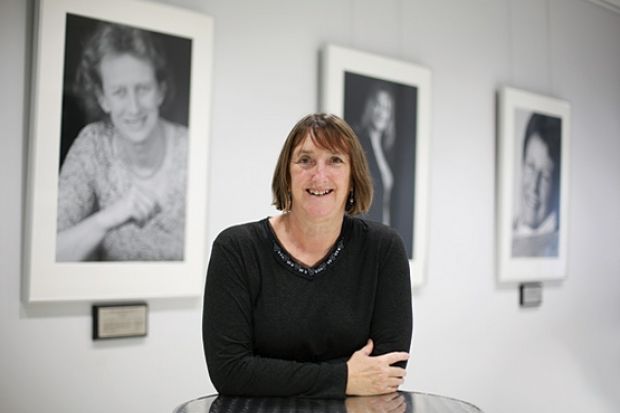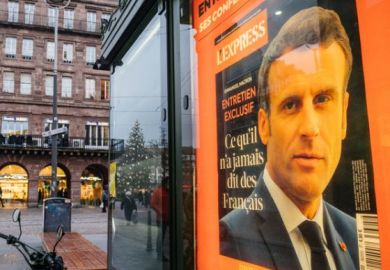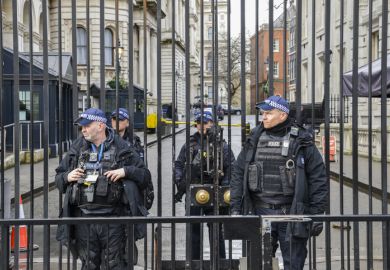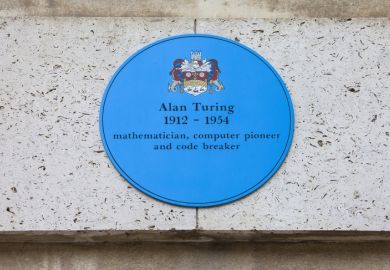Defence of the realm as president of the Institute of Physics, Frances Saunders hopes to promote scientists and engineers as an integral part of the economy
Frances Saunders has been lucky, she says. Doing what she loves led her not only to become chief executive of the Defence Science and Technology Laboratory in the Ministry of Defence, a position from which she retired this summer, but soon she will take over as only the second female president of the Institute of Physics.
As a woman in the traditionally male worlds of physics and military research, getting to the top took self-confidence and “bloodymindedness”, she told Times Higher Education. “It was about having the confidence to adopt my own way of doing things and not necessarily playing the men at their own game.”
The non-executive role of president at the IOP, which she will assume in October 2013, will be a completely new challenge, one that swaps the legwork of management for the intellectual task of providing vision and leadership, she said.
And although her first assignment is to listen - something she is already doing as president-elect - she said she already has some projects in mind. The relationship of physics with industry is one of the big things she plans to work on with Paul Hardaker, the IOP’s chief executive and a former head of the Royal Meteorological Society.
A report by the institute, The Importance of Physics to the UK Economy, published last month, found that physics-based businesses employ more than 1 million people in the UK. But Dr Saunders believes that more scientists and engineers need to become business leaders and to join company boards.
Nurturing leadership in early career scientists - whether through internships, bursaries or mentors - is one way in which the IOP can play a role in this, she said.
“We need to look at how we make sure that talent in science and engineering actually rises to the top - to become the cream on the coffee rather than being stuck at middle-management level.”
Although she was drawn to physics by a fascination with stellar evolution, Dr Saunders has in her 30-year career focused on applied science and engineering, which has involved regularly engaging with industry.
She is adamant that physicists should be less reluctant to discuss their contributions to the economy and that businesses should be more proud of their role in exploiting academic work.
The benefits of interaction will be clear when “industry values the contribution academics have made and aren’t shy about it, and academics don’t think that making money is somehow dirty”, she said. “Because actually contributing to the economy is a good thing.”
Impact champion
Dr Saunders hopes that applied science will get its chance to shine as a result of the research excellence framework’s requirements to identify research impact outside academia.
“It’s going to be really important for academics to think about where their work goes,” she said. “There’s still a place for really high-end, intellectually stimulating academic work, but there’s also an important place for people thinking about how this could get exploited - so that it doesn’t just stop with the publication of a paper.”
Spotting impact will be part of her job as a member, in an independent capacity, of the REF physics sub-panel, which will judge submissions in the field.
The REF panels were taking the impact requirements “really seriously”, she said. “We don’t want to be sold a line that isn’t supported by evidence, but if the evidence is there of impact, we’ll pick it up… I think it’s a great opportunity for people in applied physics to not be shy about boasting a little bit about where this work has ended up.”
In the REF pilot, some people “hadn’t got” impact, she added - submissions sometimes failed to demonstrate impact that was already known to panel members.
To tackle this challenge, universities are hiring staff specifically to help with the impact element of REF submissions. Last month, an investigation by Times Higher Education revealed that the sector could end up spending up to £2 million a year in salaries for such staff (“Bracing for impact may cost sector millions”, 11 October).
But Dr Saunders said that the panel would be not swayed by crafty wording and would easily spot formulaic or cut-and-pasted case studies. “It’s not just about writing clever words. We’ll be looking for… the products (or other impacts) that have come out of this, (asking) ‘where is the sustainability?’”
The impact of research will play a large role in convincing the Treasury that science funding must at least be maintained in the next spending review, whenever that comes, she added.
As president of the IOP, Dr Saunders will have to lead the charge in defence of the science budget, even if, as happened last time, the institute is not part of any formal government consultation.
“The more the community makes the case that we need to keep investing for the future rather than just rely on past investment, and the more the community comes up with persuasive examples about where that work has been pulled through and had an impact, the better.”
No silos, no silence
Uniting the science, technology, engineering and medical community, including learned societies, professional bodies and charities, will be crucial to convincing the government of that argument, she said.
It will be another big focus for her, she added. One theme “is not trying to do everything on our own. We’ve got common issues, wouldn’t it be good if we did this across the sector rather than see it in little silos?”
According to Dr Saunders, the role of membership organisations such as the IOP in tackling these issues is vital. “It’s about maintaining the health of the discipline, the next generation, and having a body that can argue for the importance of physics based on solid evidence. I don’t think members are so worried about (membership) scarves and cufflinks.”
elizabeth.gibney@tsleducation.com
The professional path
1975: Graduated from the University of Nottingham with a BSc in physics; became first female engineering trainee at British Leyland Graduate Engineering
1978: Joined the research team at Royal Signals and Radar Establishment in Malvern
1984: Received PhD from Nottingham for “Studies in the Physics of Liquid Crystals”
1992: Joined the Ministry of Defence’s Defence Research Agency. Later took on various roles within the ministry before becoming director of the Centre for Defence Analysis at the Defence Evaluation and Research Agency in 1997
2000: Became director, research councils, at the Office of Science and Technology
2003: Joined the MoD’s Defence Science and Technology Laboratory, becoming chief executive in 2005
2012: Retired from the civil service and became president-elect of the Institute of Physics.
Register to continue
Why register?
- Registration is free and only takes a moment
- Once registered, you can read 3 articles a month
- Sign up for our newsletter
Subscribe
Or subscribe for unlimited access to:
- Unlimited access to news, views, insights & reviews
- Digital editions
- Digital access to THE’s university and college rankings analysis
Already registered or a current subscriber? Login




